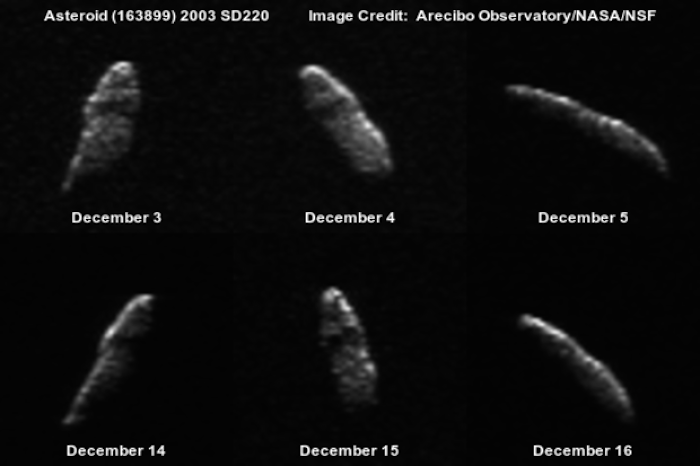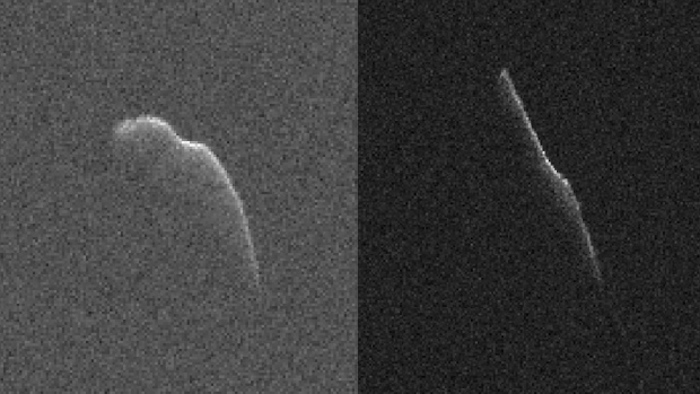.

Radar observations at the Arecibo Observatory estimate that the asteroid is at least two kilometres long and takes about 11 days to rotate once. (Arecibo Observatory/NASA/NSF)
.
Astronauts may one day ride an asteroid that is sailing past the Earth this Christmas Eve.
The stony or "s-class" asteroid 2003 SD220, which is shaped like a hot dog bun and is between one and two kilometres long, is of particular interest to scientists, because it's on NASA's list of near-Earth asteroids that astronauts could potentially visit in the future.
Fortunately for anyone who might be making toy deliveries Christmas Eve in an airborne sleigh drawn by flying reindeer, it's not coming too close on this pass — about 28 times the distance between the Earth and the moon.But as it zips by, scientists will be able to make observations that are "an important preview" for a much closer flyby in 2018, says NASA's Goldstone Observatory in California's Mojave Desert.
That year, the same asteroid will come within 7.4 times the distance between the Earth and the moon.
Recent radar observations by the Arecibo Observatory in Puerto Rico suggest that 2003 SD220 is at least two kilometres long.
Like a sweet potato
"We find the asteroid to resemble a sweet potato, or batata, which is quite appropriate for the holiday season," said Edgard Rivera-Valentin, a planetary scientist with Universities Space Research Association at Arecibo Observatory, in a statement.
If astronauts do visit the asteroid, they'll find their days there very long — the space rock takes more than 11 days to rotate once.
The Goldstone observatory has also captured some radar images. Based on them, Lance Benner, who leads NASA's asteroid radar research program at the space agency's Jet Propulsion Laboratory, estimates that the asteroid is at least 1.1 kilometres long — slightly different from Arecibo's estimate — and "highly elongated" in shape.
.

These images of the asteroid were taken on Dec. 17 (left) and Dec. 22 by scientists using NASA's giant Deep Space Network antenna at Goldstone, California. (NASA/JPL-Caltech/GSSR)
-
Thursday's flyby is the second of three asteroid flybys this week — the first, 1995 YR1, flew by on Dec. 23. It was only 300 metres wide, but it came the closest, within 17 times the distance between the Earth and the moon.
The third, 2008 CM, will be on Dec. 29 — a 1.2 kilometre-wide asteroid that will pass within 23 times the distance between the Earth and moon.
All three of those asteroids are listed by the International Astronomical Union's Minor Planet Center as being "potentially hazardous" — but none of them is coming close enough pose any risk on this pass.
Quelle: CBC4496 Views
